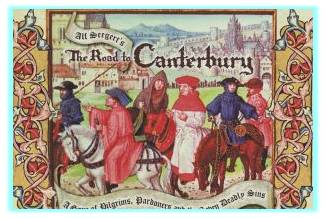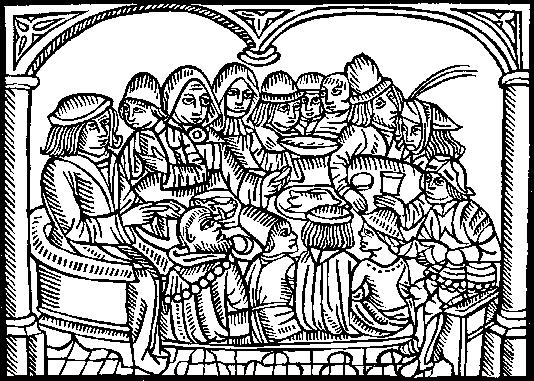CHAUCER'S USE OF PHYSIOGNOMY IN CHARACTER PORTRAYAL:
A. The Summoner:
According to the medieval sciences,
the Summoner is afflicted with a species of morphea (a skin disease resulting
from a corruption of the blood) known as gutta
rosacea, which has alreadv developed into that kind of leprosy called
alopecia. Gutta rosacea covers the
skin of the face with livid red pustules. But the Summoner has, besides this,
`scalled browes blake and piled herd', 'narwe eyes', 'whelkes whyte' and
`knobbes' on his cheeks. Chaucer is evidently following contemporary medical
opinion in supposing that the Summoner's skin disease has already developed
into that type of leprosy that is produced de sanguine, or alopecia.
 |
| Geoffrey Chaucer |
B. The Cook:
The Cook is also affected with kind
of cutaneous eruption which is less malignant than the Summoner's but more
offensive to the eye. It is generally agreed that his `normal’ is to be
identified with what the medieval medical writers call the malum mortuum. It is a species of ulcerated, dry-scabbed apostemas
produced by a corruption in the blood. It is an infirmity infecting the arms
and shins of the patient. It consists of dry. ulcers slightly generative at
times of bloody matter, sometimes accompanied by severe itching. The cause is said to be much consumption of melancholie food (e.g.,
flesh of cattle and salt fish) and unhygienic sexual practices, unclean habits,
lack of frequent bathing and continuous wearing of soiled clothes, drinking of
strog wines and so on. So the threadbare sketch of the Cook's pre-eminence in
his profession, mormal and his knowledge of London ale actually reveal all the elements
of his personality. Similarly, the Summoner’s tainted blood strongly indicates this
Archdeacon's messenger has called too promiscuously upon certain erring women
of his diocese with other than the professional purpose of haling them to the
court.
C. The Pardoner:
The Pardoner's physiognomy is
clearly denoted—long straight hair as yellow as wax, which hangs thinly spread
over his shoulders, wide open and glaring eyes, with voice high-pitched and
thin as a goat, no indication of a beard, and a long scrawny neck. The ancient
physiognomist Antonius Polemon Laodicensis says that glaring eyes prominrntly
set indicate a man given to folly, a glutton, a libertine and a drunkard. High,
thin voice with such eyes are directly associated with shamelessness,
impudence, gluttony and licentiousness. Long, soft hair, fine in texture and
reddish or yellow in colour indicates an impoverished blood, lack of vitality,
and effeminacy of mind. The sparser the hair, the more cunning and deceptive is
the man. Another authority opines that a long thin neck is a sign of garrulity,
haughtiness of spirit and evil habits, and a man beardless by nature is endowed
with a fondness for women and for crafty dealings, besides being impotent.
The Pardoner has been most
unfortunate in his birth. He carries upon his mind and his body the marks of
what is known to a physiognomist as a eunuchus
ex nativitate. An authority in the fourth century says that those who are
eunuchs by fault of nature possess certain evil characteristics which
distinguish them from other men. They are usually cruel, crafty and vicious.
The eunuchus ex nativitate is held to
lack the redeeming qualities of even the eunuchus
qui castratus. The ones who have never had a beard are worse.
Most of the medical authorities cite Polemon as the
authority on eunuchs. He says:
"When the eye is wide open and like
marble, glitters and coruscates, it indicates a shameless lack of modesty. This
quality of the eyes is observed in a man who is not like other men, but is a
eunuch. I have only known one of this kind. He was lustful and dissolute above
all moderation. He had a prominent forehead, a long, thin neck, and his cries
were like women. He took particular care of his own person by nurturing his
abundant hair, rubbing his body with medicated unguents and by employing every
expedient that might excite a desire for sexual pleasure. He was given to
scornful jesting, and whatever came into his mind, he acted upon immediately.
Being learned in Greek, he was accustomed to use that the most. He frequented
cities and market-places, meditating on justice and gathering men together in
order that he might display evil. Above all, he was a very astute wizard,
practicing life and death for men; wherefore he so influenced people that vast
crowds of men and women flocked to hear him. Moreover, he persuaded men that he
was able to force women to them just as they sought women and surreptitiously
he caused to transpire that which he had predicted. As an instructor in the
doing of evil he was a past master; he collected all kinds of deadly poisons.
All the power of his ingenuity was directed toward the performance of these
things. Whenever, therefore, you see such eyes, you may understand that their
possessor is similar to this kind of eunuch."
D. The Wife of Bath:
Dame Alisoun's body and mind are
influenced by the dominant planet ruling at her birth, Venus. The children of
Venus are beautiful, tall, delicate, given to drink and little food, music and the
arts, and to passion. They are stately, plump but not stout, graceful, with
white skin touched with pink. But unfortunately, these beneficial aspects of
Venus are clouded by the presence of Mars, and the Wife is finally shaped by
both. So she is endowed with a stocky build which is more or less ungraceful,
buxom, and of medium height. The strength which should have accompanied grace
and beauty of body is distorted into an abundance of fecund energy; her large
hips indicate excessive virility. In place of the attractive face—round but not
too large, with finely chiseled features, resplendent black eyes and finely
arched brows, a lovely peach-bloom complexion set off by thick curling hair of
a dark shade--all of which Venus might have given her, she has inflicted upon
her by the malignancy of Mars a slightly heavy face inclined to fatness,
characterized by perhaps coarsened features and certainly by a red or florid
complexion, which indicates immodesty, loquaciousness and drunkenness. Her
voice, which should have been sweet, low and well-modulated, is harsh,
strident, and raised continually in vulgar jest and indelicate banter. Such a
voice is especially significant in its betrayal of the Wife's voluptuous and
luxurious nature. And where the love-star might have given her small sharp
teeth white as alabaster, Mars is perhaps responsible for her 'gat-tothed'
mouth, where gap-teeth signify that she is envious, irreverent, luxurious by
nature, bold, deceitful faithless and suspicious.
This remarkable distortion of her
body is paralleled by a warping of her character resulting from the Venus-Mars
conjunction in Taurus. Those born under the sole influence of Venus are
naturally of a happy, joyous disposition, amiable, charming, attractive,
delighting in dance and all such innocent entertainment, but withal gentle,
refined, and calmly dignified. They are religious in nature, just in their
dealings with men, leaders of noble lives and of an artistic nature, loving
delicate and pleasant odours, the colours of elegant apparel and precious
jewels. Endowed with the warmest of hearts, they are highly prone to violent
amours with the opposite sex, though their amatory relations need not
necessarily lead to vice.
Such a woman the cloth-maker of Bath might have been, but
for Mars. The natural cheerfulness resolves itself into a kind of crude and
clamorous hilarity, an overflow of superabundant animal and intellectual
spirits. Her religious instinct has been debased to her going to vigils and to
preaching simply to show off her finery, and attending to Miracle plays or
going on pilgrimages just to satisfy an idle curiosity or to find another lusty
husband. The artistic temperament has been cheapened by Mars, so that she
flashily decks herself out in gaudy colours—in scarlet dresses and hose, brand
new shoes and silver spurs—and adorns herself on Sundays with cover-chiefs
weighing ten pounds and on pilgrimage, with a hat as large as a shield. Mars
has given her a steady hardiness and a body so full of `ragerye' that even at
forty, she is still 'faire and well bigoon', and it is Mars who impels her to
gain at all costs the dominating power over her husbands and who makes of her a
scold, a wrangler and a striker of blows.
---------------------------------------
Bibiloliography: • W C Curry: Chaucer and the Medieval Sciences.



